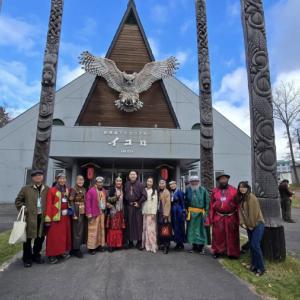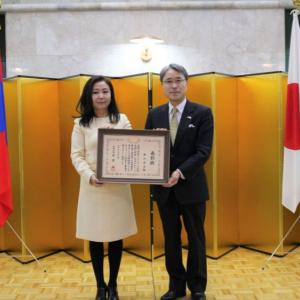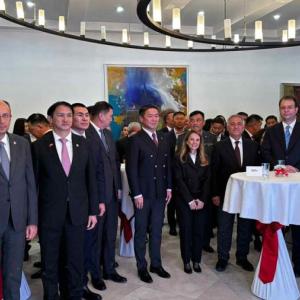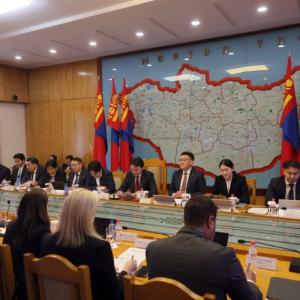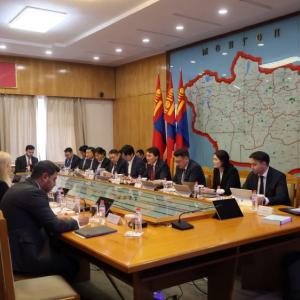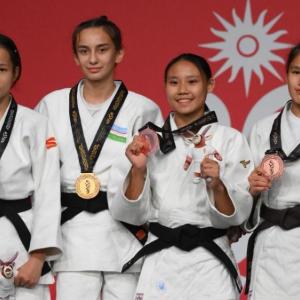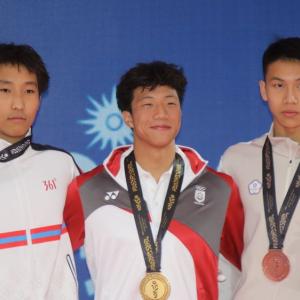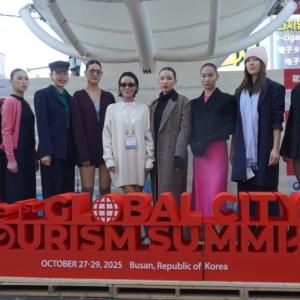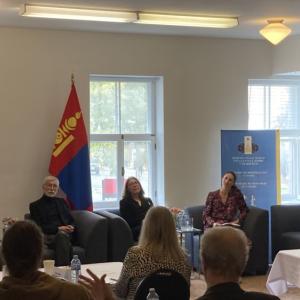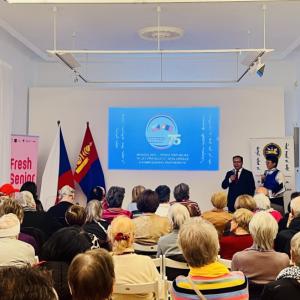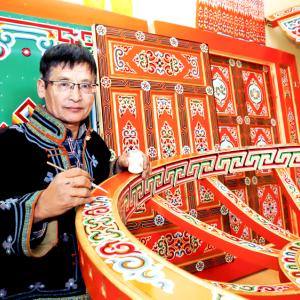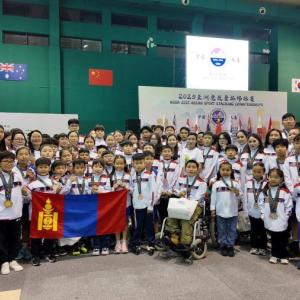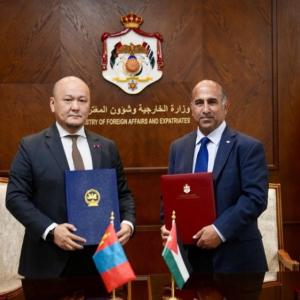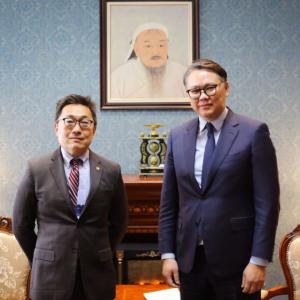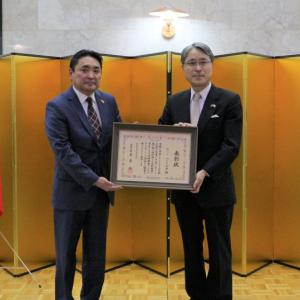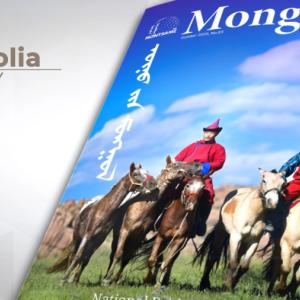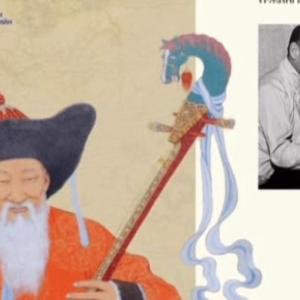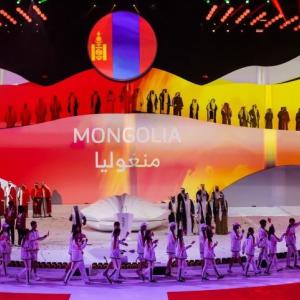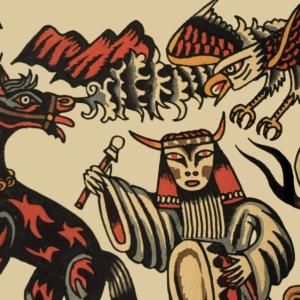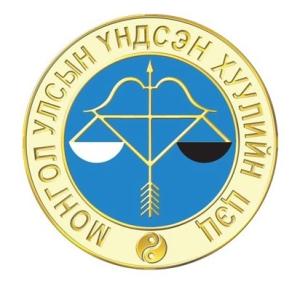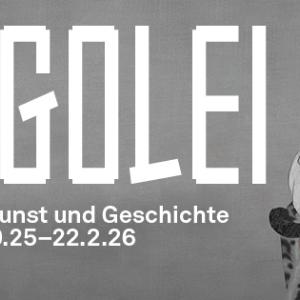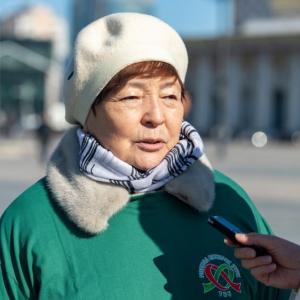A Man Brought Borjigon Horse-Head Fiddle Back to its Homeland
Art & Culture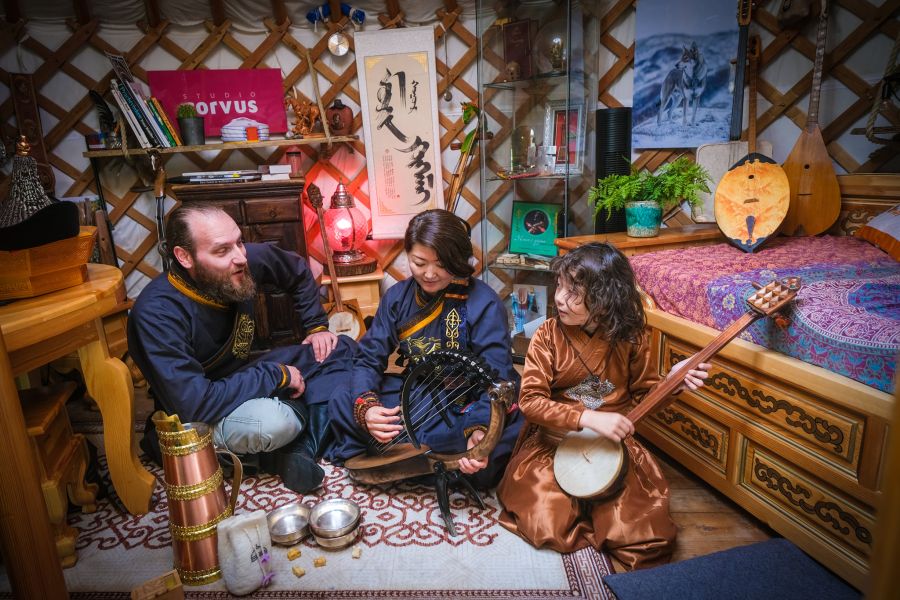
Ulaanbaatar, February 23, 2023 /MONTSAME/. MONTSAME Mongolian National News Agency had an online interview with Rowan Lee Hartsuiker, who found joy in Mongolian music, and fell in love with throat singing and horse-head fiddle while he was searching for fascinating music. He brought vintage old Borjigon horse-head fiddle, which has more than 400 years of history back to its homeland-Mongolia.
What
was your first impression when you came to Mongolia?
My first trip to Mongolia was amazing, and I was excited.
When I landed in Ulaanbaatar for the first time and was out of the plane, I saw
all of these little white dots, which were the Mongol Yurt. That was a
fantastic sight. I saw all the mountains from out of the sky. That was amazing.
When we went to Mongolia’s countryside, I was also amazed. I thought it would
be beautiful, but it was more beautiful in real life. We visited many towns, smaller
soums, and many different places, where all the people were friendly. Everyone
says that Mongolian countryside people are very friendly. It is true.
Sometimes, they are a little shy, maybe because of the language barrier. That
is even better. It is a way to show how friendly they are.
What
made you decide to learn throat singing? Which one did you discover first,
throat singing or horsehead fiddle?
I met a Dutchman, when I was learning Scottish bagpipes. He
was a mouth fiddle Maker. He introduced me to the Khuumii (throat singing) music
of Tuva, southern Siberia. When I heard that, it was mind-blowing. I had not
listened to that music before and was immediately impressed. Then, when I came
home that day, I started my research immediately and learned about the
countries, where also a lot of Khuumii music was made. I found out the solid
Khuumii culture combined with Morin Khuur (Horse head fiddle) in Mongolia. I
started practicing right away, from the first day, because I was amazed by this
technique. I was fascinated that the human voice can make so many things. This
was explicitly and extremely interesting for me because this sounded like a
musical instrument made for me. I was interested to learn how to do these
techniques and sing wherever I am. That was the main reason I decided to learn
throat singing, to see how far I can practice with my voice to create all these
unique sounds. About horse head fiddle, I bought my first Morin Khuur in 2008,
but it has been sitting in my room for many years. I started becoming serious
in Mongolian music about 5 or 6 years from now.
What
Mongolian traditional folk music instruments do you play, in addition to horsehead
fiddle and Altai Zither?
I play Morin Khuur and Altai zither, and I play tovshuur (two or three-stringed lute). I play all types of mouth harp, iron harp and bamboo jaw harp. I love those little instruments because you can improvise with these mouth harps very well. They are just fun instruments. I still play Scottish bagpipes. The type I usually play is small Scottish bagpipes.
How do
you feel participating in Euro Morin Khuur Festival? Please explain the award
you have received.
Last year, there was the first Morin Khuur Festival in
Europe; It was ten hours of driving, but we went there, and it was terrific to
meet all of these musicians and the Mongolian community in Germany. I knew many
musicians from there. It was nice to meet new people as well.
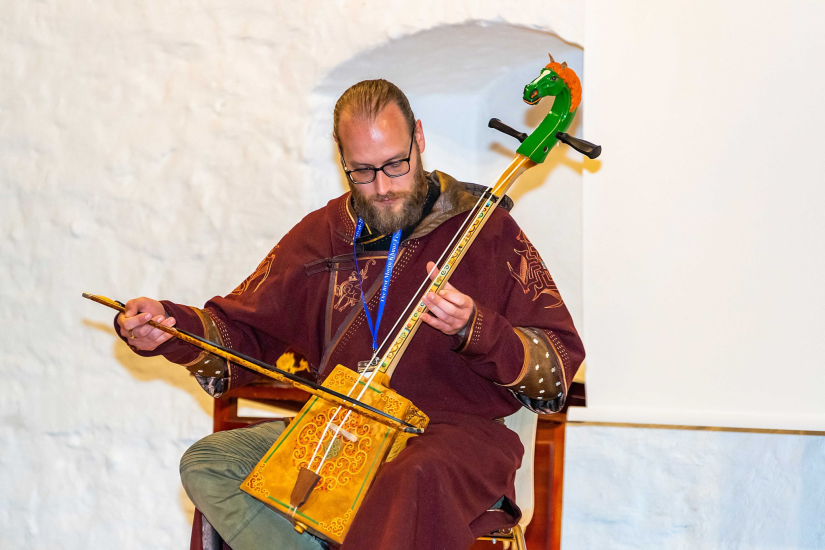
I attended the Morin Khuur competition, but I was so incredibly nervous. I sometimes have a little stage fright before I go to stage, but it goes away after a few minutes, or after one or two songs, it becomes ok. It is natural for a musician during the performance. I do not play on the stage that often. If you play on set every day, you will have less of it, but I was extremely nervous about this competition. It was a competition, and there was a judge, respected musicians, composers, and directors a few meters in front of me, so I was sweating. I was shaking, and it wasn’t good, but I still managed to play three to four Mongolian songs (tatlaga, folk song).

I was even surprised to win something, and I won the third
place. It was terrific to win third place in the first European Morin Khuur
Festival. Next time, I do not know when I will definitely attend next European
Morin Khuur Festival again. I will practice more, and I hope I will be less
nervous.
Over
400 years old Mongolian horsehead fiddle is gifted back to Mongolia. Can you
tell us more about the other musical instruments at the auction and why did you
choose to get only this horse-head fiddle?
Mongolian people now know the story about this horse-head fiddle, and many people talk about it. The first time I saw it, I was a student in Mongolia. I immediately knew it was a vintage old Morin Khuur because I recognized its style but was not interested in buying it then. I just said to the man who owned the music shop, “It looks stunning.” He replied, “Yes, it is a unique instrument, but it is not for sale.” I told him, “I am not here for that instrument; I just wanted to say that it looks beautiful.” I bought a different instrument. I think it was around 2006. I visited that shop a few more times in past years and always saw that instrument.

Eventually, when I became more active in Mongolian music, I asked the man again, “Will you sell it?” He said that he would never sell it because it was from his private collection. When I became more familiar with Morin Khuur, I realized how rare these vintage old Morin Khuurs were in Mongolia. Only a few years ago, like 2019. I was interested in buying it. Even though he said he would sell it, I could not afford it. Later, I heard, unfortunately, this man passed away, and someone bought all the instruments and was going to sell them in an auction. I thought that this would be my last chance. Last year in 2021, my wife and I went to the auction, and we just asked how much you wanted for it. There were many different instruments in this auction. In an auction, nothing goes cheap. I walked around the auction, watching the old violins, cellos, Indian musical instruments, or African instruments. All of the instruments are real and old, somewhere of museum quality. At that time, I said, “Oh, all these are beautiful, but let’s get this Morin Khuur to surprise my teacher.” I would say to him, “We got it. I want to give it to you.” That is how that happened.
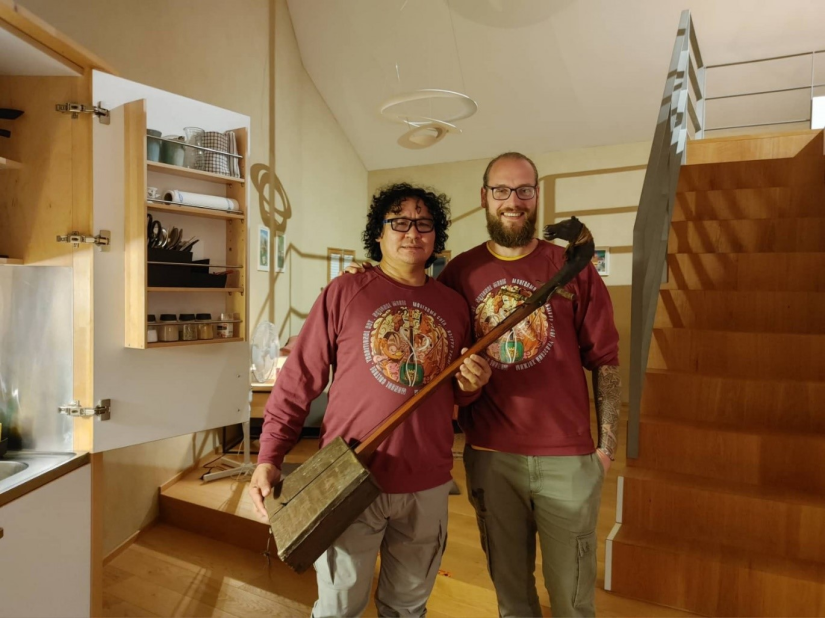
Did
you participate in the ceremony to place the fiddle at Mongolian Theater
Museum? Please, share with us your feeling during the ceremony.
Unfortunately, I did not. We are not able to travel to
Mongolia. We couldn’t travel. Fortunately, my mother-in-law wanted to go, so I
was pleased. We felt good about it. In addition, we woke up at 04:00 am to
watch Facebook live video. It had an emotional feeling to watch that live online.
Even though we were not there in person, but mother-in-law went there to
witness this. She thought it was terrific.
Will
you please introduce your family? Do you plan to teach your son how to throat
sing?
My wife’s name is Sarantungalag Myagmarsuren, and we call her Saran for short. My son Jiro Jamuha Hartsuiker and we call him Jiro for short. He is seven years old. My wife also has an older son. He is 22 years old, his name is Sukhjin, and his Mongolian name is Sukhbat. Sukhjin lives in Amsterdam.
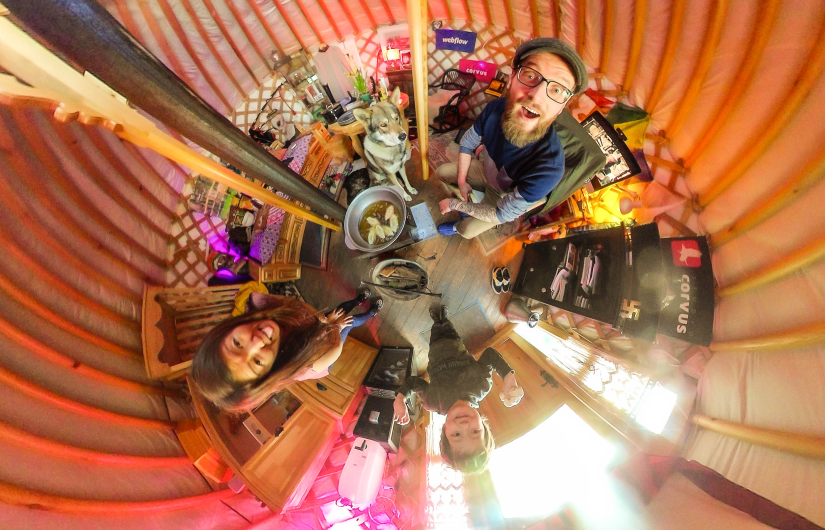
Jiro grew up hearing it all day long, so he likes it, but I
do not think he has any interest in learning throat singing in Mongolian yet.
Sometimes we do funny exercises to have fun. There has yet to be any genuine
interest in learning it. I do not mind it. I do not want to force him to learn
that because I want to do it. He grew up with the traditional Mongolian music
around him all day long, even though we live in the Netherlands. I hope his
interest grows in learning Mongolian music or throat singing, maybe in musical
instruments. I cannot say for sure. We want to show him what music is, and he
will grow up with it. It is usual for him to hear it all day long, every day.
Let us see what happens next year when he becomes older.
Please
introduce us your Altai Yurt and Studio Corvus. Why did you decide to have
two yurts? Do you receive guests who want to know about traditional Mongolian
yurt?
We have two yurts in our garden. We are planning to move to
a new place in June next summer. We liked having these yurts so much that we
want to expand into having four to five Gers. I always call it Yurt in English
because it is like a more international name. I have been working in one of our
yurts for the past six years, so I work full-time in our Mongolian yurt, and I
like that. It is like working outside in the garden all year long, and you hear
all animals around, birds, wind, and rain. It is like working outside also
inside at the same time. The beauty of Mongolian yurt is that you always connect
elements around you. It is beautiful inside the yurt. It feels very calm, very
natural. It is an ideal office, but not just an office, it is also a living
room, bedroom, kitchen, and bathroom. Everything is in one, and that is what I
love about the yurt.
Next to my yurt, about 20 meters away, we also have a
bigger yurt. My office yurt has four walls, but the bigger one has five walls.
My wife uses that one for tourists and guests to introduce them to Mongolian
culture, life, food, and music; people love that. It is almost booked all
around the year. Although, the winter season is less busy. It is the perfect
way to introduce people to part of Mongolian culture, even in the middle of the
Netherlands.
Saran,
seeing guests welcomed in Mongol Yurt in the Netherlands is beautiful. When and
how did you get this idea to introduce Mongolian culture in an authentic
setting? Who first initiated the idea of bringing or building a Mongol Yurt in
the Netherlands?
My husband and I both want to share and promote Mongolia,
its culture, tradition, clothing, and music to European people and even the world
because the Netherlands know very little about Mongolia.
Rowan got the idea to bring and build Mongol Yurt to make
his office. I supported the idea, and we moved into a house with a big backyard
for the yurts. We brought two Yurts from Mongolia six years ago.
How do
the guests get to know about Altai Yurt? Will you share with us their feelings?
My husband is a web designer, and he made a website for
Altai Yurt. We usually have guests from the Netherlands, Germany, the USA,
Great Britain, Egypt, Turkey, and many other European countries. Guests coming
into the yurt for the first time expressed having a unique and cozy feeling.
Some say getting feel as if they were in Mongolia. During the stay, most guests
love ordering Mongolian cuisine because, as they say, it makes their experience
complex
 Ulaanbaatar
Ulaanbaatar











